Disclosure: This post may contain affiliate links. I may earn a small commission for my endorsement, recommendation, testimonial, and/or link to any products or services from this website.
This Roasted Red Pepper Pasta is made rich and creamy with a homemade red pepper sauce and al dente pasta. Simple, tangy, and delicious! Vegan, Gluten-Free Option.
This Roasted Red Pepper Pasta is the perfect simple, weeknight dinner. It’s made entirely from scratch using wholesome ingredients yet comes together in just a few simple steps. Finish with your favorite fresh herbs and red pepper flakes for a meal the whole family will remember.
Table of Contents
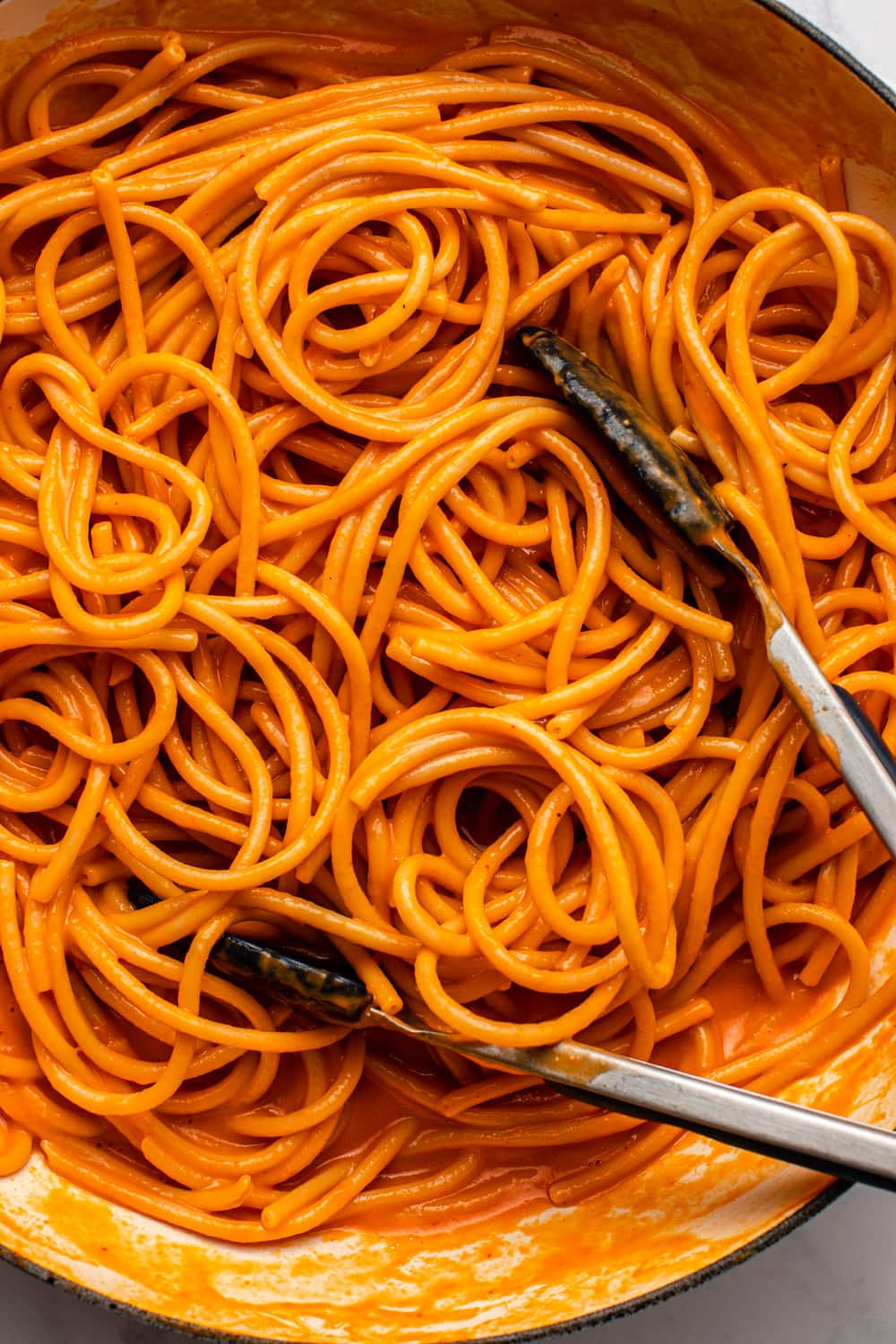
A Dreamy Pasta Sauce Without Tomatoes
If you’re looking for a homemade pasta sauce that’s free of acidic tomatoes, you’re going to fall in love with this luscious, flavor-packed roasted red pepper sauce. It’s made with just 5 simple ingredients in less than 20 minutes and is the dreamiest addition to your favorite pasta. It’s also meal prep friendly, freezer friendly, and extra-budget friendly when you make it with my Homemade Roasted Red Peppers. What more could we ask for?
What You Need for Roasted Red Pepper Pasta
Making creamy, dreamy pasta sauce from scratch is so much easier than you think. All you need is these 5 basic ingredients:
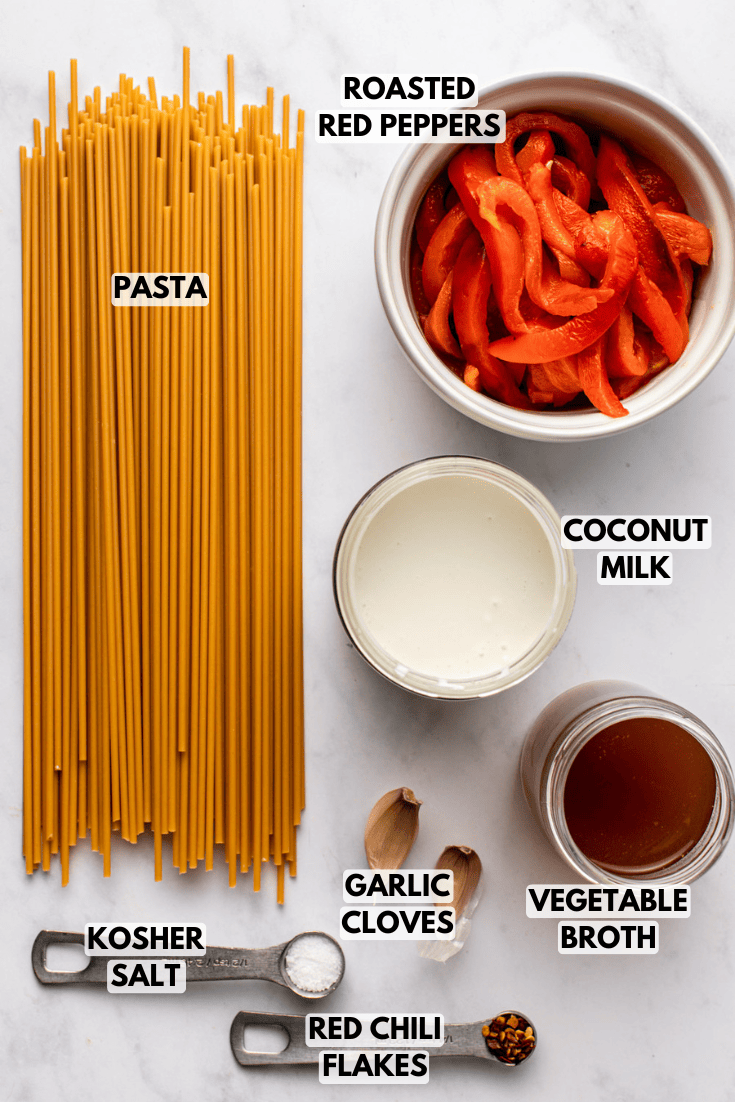
- Pasta: Both long and short cut pasta varieties will work well. Use any pasta of your choice.
- Roasted red peppers: Roasted red peppers are KEY to achieving a pasta sauce with a deep, tangy flavor and creamy texture. If you’ve got fresh red bell peppers at home, I highly recommend Making Your Own Roasted Red Peppers at Home. Otherwise, a 12 ounce jar of your favorite store-bought brand will do.
- Coconut milk: This pasta sauce is both dairy-free and vegan and canned coconut milk makes this pasta sauce creamy and rich. No heavy cream needed.
- Broth: Vegetable broth rounds out the flavor and adds necessary salt to the mix.
- Garlic: Adds flavor without being overly garlicky. If you’re out of fresh cloves of garlic, use 1/4-1/2 teaspoon of garlic powder.
- Red pepper flakes: Optional, but if you love a pasta sauce with a slight kick, red pepper flakes will take your creamy pasta sauce to the next level.
How to Make Roasted Red Pepper Pasta
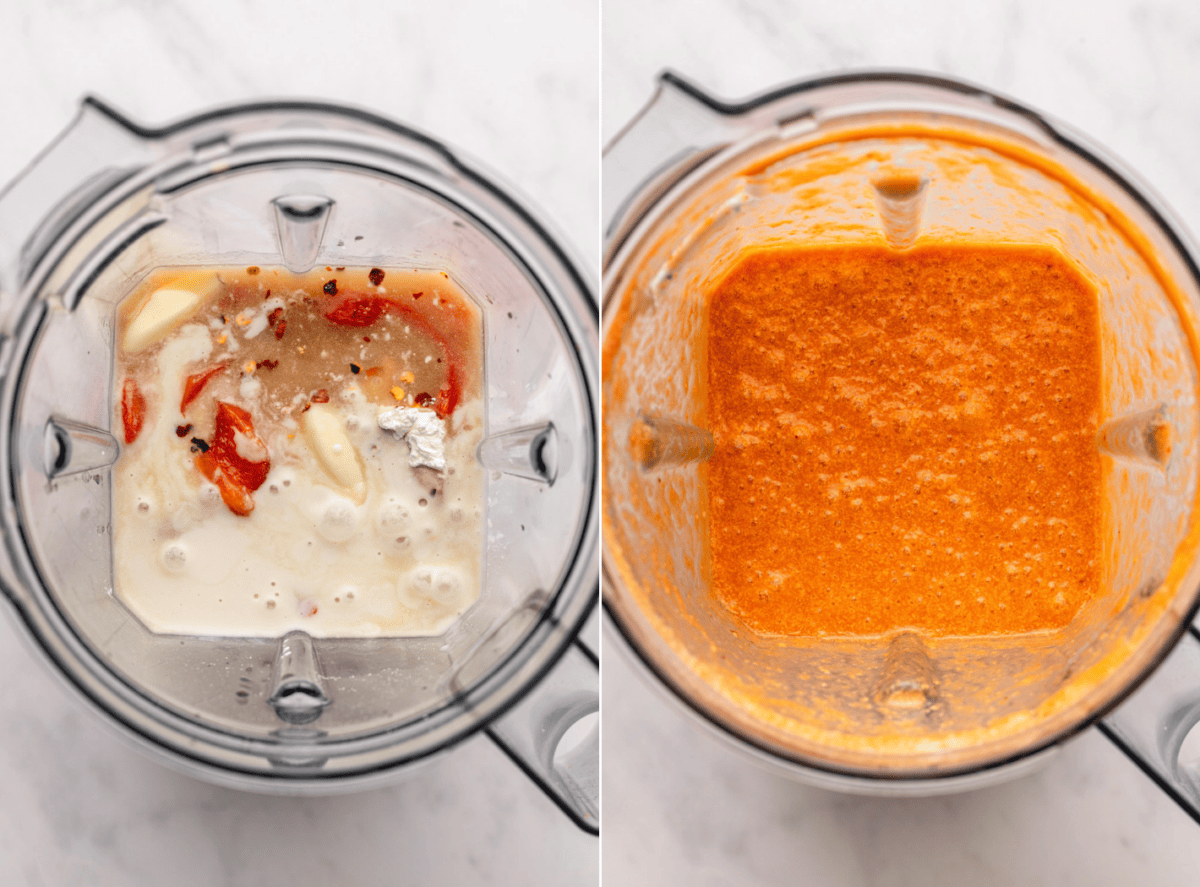
- Cook the pasta in a large pot of salted water according to package directions, or until al dente. Drain and set aside (do not rinse!).
- While the pasta cooks, blend the roasted red peppers, garlic, coconut milk, vegetable broth, red chili flakes, and salt until smooth and creamy.
- Pour the smooth sauce into a large pot or saucepan. Simmer until bubbly and thickened.
- Add the cooked pasta to the homemade pasta sauce and mix until well coated.
- Season with a pinch of salt to taste, if necessary, then serve while warm with fresh basil and chili flakes to taste.
Caitlin’s Cooking Tips
- Rinse the peppers if using canned peppers. I always make this delicious pasta sauce with my Homemade Roasted Red Peppers, but if you’re going the store-bought route, rinse and drain the peppers well before using. This prevents the bold flavor from being watered down.
- Use the correct pasta weight. This pasta recipe was developed using 8 ounces of dried pasta (about 1/2 a package of a standard size package of pasta). If you want to cook the full package of pasta, double the creamy sauce to keep things saucy!
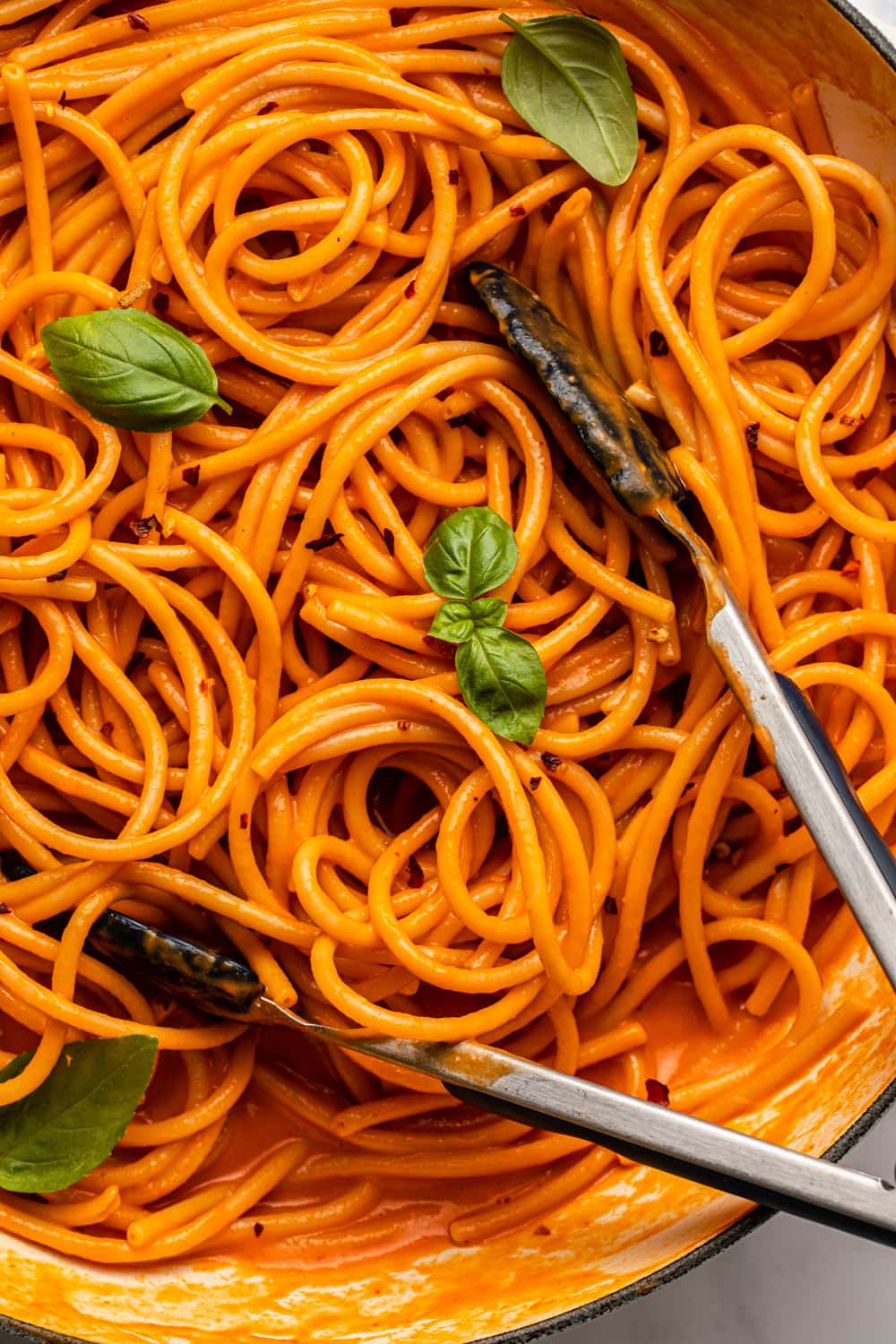
Serving Suggestions
This creamy Red Pepper Pasta dish is hearty enough to serve as a standalone meal for a quick dinner or lunch. If you’re looking to make this pasta dish even more nourishing and filling, mix in some of your favorite veggies, fresh greens, or your favorite plant-based protein. Finally, serve with a side of crusty bread slathered with vegan butter or homemade vegan garlic bread.
If you’re looking for more tomato-free pasta recipes, you’ll also love this Vegan Mushroom Stroganoff, this No-Boil Chickpea Noodle Casserole and this Creamy Vegan Alfredo Sauce with Zucchini!
How to Store Roasted Red Pepper Pasta
Leftover pasta will keep in the fridge for up to 5 days when stored in an airtight container. The red pepper sauce can also be frozen separately from the pasta for up to 2 months.
To freeze, transfer the roasted red pepper sauce directly into a freezer-safe container straight from the blender. Allow to defrost overnight in the fridge, then pour into a large pot or saucepan and resume with recipe step 3.
Leftovers will reheat best in a microwave-safe bowl or on the stovetop until warmed through. If the sauce seems on the drier side, add a splash of water or broth to make it creamy again.
Substitutions and Variations
- Gluten-free option: Use gluten-free pasta in place of the wheat-based pasta. The roasted red pepper sauce is naturally gluten-free as is.
- Roasted pepper options: I highly recommend trying my Homemade Roasted Red Peppers recipe, but a 12 ounce jar of store-bought peppers of choice will work.
- Coconut milk options: If you have a tree nut allergy, replace the full-fat coconut milk with a full-fat oat milk or soy milk. Avoid thin plant-milks such as store-bought almond milk. The creamier the plant-milk, the more creamy and luscious your sauce will be.
- Broth options: I used a full-sodium vegetable broth, but low-sodium will work if you are sensitive to sodium.
- Add additional flavor: Stir in nutritional yeast, vegan parmesan cheese, Italian seasoning, black pepper, or smoked paprika to taste.
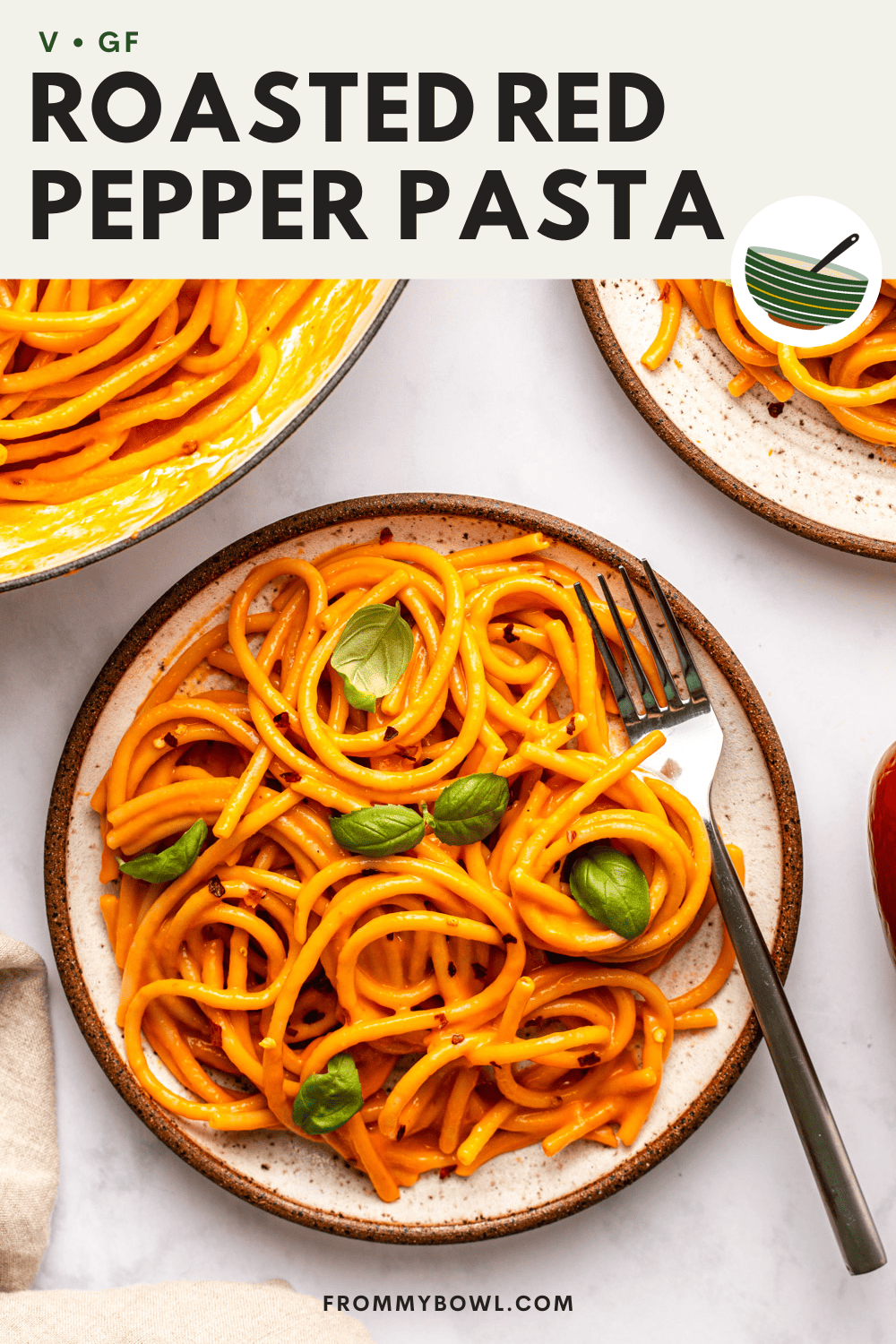
Recipe FAQs
Simmering the sauce for 5-7 minutes will thicken it naturally without any cornstarch or similar thickening agents. If the sauce appears too runny after 5-7 minutes, allow the pasta to sit in the sauce for an additional couple of minutes before serving. The starches in the pasta will help thicken up the sauce.
I wouldn’t recommend it. Raw red bell peppers have a very different flavor profile and texture compared to roasted peppers and will cause the flavor in this sauce to fall flat.
In any of my recipes that call for vegetable broth I am almost always using my Homemade Vegetable Broth. It’s one of my favorite ways to reduce waste and creates a broth that’s much deeper in flavor than anything you can purchase at the store. If a recipe calls for bouillon paste, I recommend Better than Bouillon Organic Vegetable Base.
Enjoy! If you make this recipe and decide to share it on Facebook or Instagram, don’t forget to tag me @FromMyBowl + #FromMyBowl! I would also love it if you could leave a comment below with a recipe rating! Thank you for the support 😊
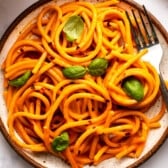
Roasted Red Pepper Pasta
Ingredients
- 8 ounces pasta regular or gluten-free
- 8.5 ounces
roasted red peppers * drained and rinsed if using canned - 3-5 cloves garlic
- 1 cup full-fat coconut milk
- 1/2 cup vegetable broth homemade or store-bought
- 2 teaspoons cornstarch or arrowroot powder
- 1/4 teaspoon red chili flakes plus more for serving (optional)
- 1/2 teaspoon kosher salt
- Fresh basil for serving (optional)
Instructions
- Cook the Pasta: Bring a large pot of salted water to a boil and cook the pasta until al dente, according to the package instructions. Drain the pasta once cooked, but do not rinse.
- Blend the Sauce: Add the peppers, garlic, coconut milk, vegetable broth, red chili flakes, and salt to the blender. Blend on high for 45 to 60 seconds, until the sauce is smooth and creamy
- Simmer: Pour the sauce into a large pot or saucepan over medium heat. Bring the sauce to a simmer and cook for 5 to 7 minutes, stirring frequently, until bubbly and thickened. Add the cooked pasta to the pot, then use a spoon or tongs to mix everything together, adding more salt to taste if necessary. If the sauce appears to runny, allow the pasta to sit for an additional 3 to 5 minutes to absorb more of it.
- Serve: Transfer the pasta into serving bowls, then top with fresh basil and more chili flakes or as desired. Serve warm; store leftovers in the refrigerator for up to 5 days.
Recipe Notes
- Roasted Red Peppers: You can use homemade or store-bought peppers for this recipe. If you go with store-bought, I recommend purchasing a 12 ounce (340 g) jar. The jar weight includes the liquid that holds the peppers, which we will not use for this recipe.
- Gluten-Free: Use gluten-free pasta to make this recipe gluten-free
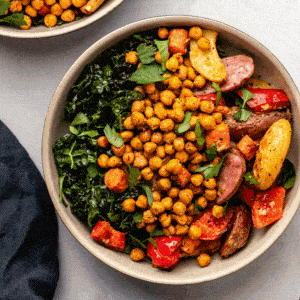
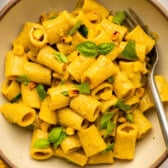



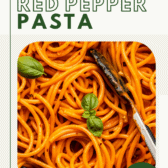
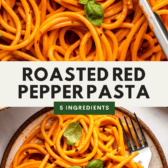

So tasty! And super easy to make!
Surprisingly delicate and floral with a hint of smokeyness! This is a fantastic recipe.
Thank you so much, Carolyn!
So so tasty! Even tasted good cold the next day. Will be making this a lot!
Thanks for the review, Morgan!
Got a bit confused by the cornstarch (which is in the ingredients list but not in the directions)! But damn, this turned out DELICIOUS and is going into my regular rotation for sure. Thank you, Caitlin!
Glad it worked out. Thank you Emily!
I assume you add cornstarch in with everything else in the blender?
The cornstarch is mentioned in the ingredients but is not utilized in the recipe instructions. It’s included in the ingredient list as a potential thickening agent for the sauce.
If you choose to use the cornstarch to thicken the sauce, you can do so by following these steps:
In a small bowl, mix the cornstarch with a couple of tablespoons of water to create a slurry.
When the sauce is simmering in the pot (Step 3), you can add the cornstarch slurry to the sauce.
Stir well to combine, and continue to simmer for a few more minutes until the sauce has reached your desired thickness.
Adding cornstarch can help thicken the sauce if needed, but if you find the sauce is already thick enough to your liking, you can omit it.
So easy to make. Very tasty. Also recommend Simply Delicious Vegan book.
Thank you so much, Tina!
This recipe is so EASY and absolutely delicious!! 🙂 I added some broccoli pieces to it because I always am trying to incorporate more veggies! Thank you so much for sharing this recipe!! I love your blog!!
Thanks so much for making it! And glad you’re enjoying the blog!
Hey team, what is the vegie or mushroom boullion that I see Caitlin spooning into recipes? Brand name? Thank you!
More than likely it would be the homemade recipe! Great way to reduce waste from compost!
Excellent Recipe!
Thank you!
Looks fantastic! I’m just a little confused about the cornstarch. You mention it in the ingredients but nowhere else. Is it ment to be used somewhere?
The cornstarch is mentioned in the ingredients but is not utilized in the recipe instructions. It’s included in the ingredient list as a potential thickening agent for the sauce.
If you choose to use the cornstarch to thicken the sauce, you can do so by following these steps:
In a small bowl, mix the cornstarch with a couple of tablespoons of water to create a slurry.
When the sauce is simmering in the pot (Step 3), you can add the cornstarch slurry to the sauce.
Stir well to combine, and continue to simmer for a few more minutes until the sauce has reached your desired thickness.
Adding cornstarch can help thicken the sauce if needed, but if you find the sauce is already thick enough to your liking, you can omit it.